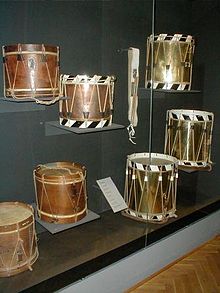Membranophone

Membranophon (Latin-Greek made-up word, "Fellklinger") describes a musical instrument that has a membrane to produce sound . This membrane can be a stretched animal skin , also parchment , a plastic film, paper or the like. In order for the membrane to sound, it has to be made to vibrate. This is usually done by striking it like a percussion drum, which is one of the percussion instruments . There are also friction drums , the membrane of which is wiped with an object, and plucking drums known in India as ektara. All types of drums are membranophones. In the case of the Kazoo and Mirliton , the membrane is made to vibrate by blowing .
Depending on the construction of the membranophone, a sound with a clearly audible fundamental tone or a rather diffuse mixture of different frequencies is created when struck. The instruments that can be heard tonally include the timpani , the boobam and the tabla . Boo-bam and Tabla Tarang can be used to form melodies because of their many individual instruments.
Design
Drums can be divided into three categories according to their shape:
- Frame drums (example tambourine )
- Tubular drums , single-headed and open at the bottom (e.g. Concert-Tom , Octoban ) or double-headed, d. H. closed on both sides (example bass drum )
- Boiler drums (Example timpani )
Sound formation
The physical fundamentals of sound generation in membranophones (in the following: drums) are known, but in a specific case it is complicated to assign individual physical effects to a sound image.
There are some similarities between the behavior of loudspeakers and drums. The body - like the loudspeaker housing - has a significant influence on the vibrations of the membrane and its sound radiation, but in both cases it has no active function: even if the body vibrates, i.e. emits sound, it is so significantly less that it acts as a sound source is mostly imperceptible to the batter head. The body functions as a baffle and as a mass (counterweight). With small, short bodies, low frequencies are attenuated because there is an acoustic short circuit and the kinetic energy is partially transferred to the body. Some frequencies are amplified by resonance between the membrane-air volume system in the body. Both - undesirable with loudspeaker boxes - contribute to the sound character.
The suspension of the diaphragm makes the essential difference between loudspeakers and membranophones. While the loudspeaker cone is centered by the bead and spider and can otherwise vibrate freely, the drum membrane is tightly stretched around the edge of the body. There are different vibration modes of the membrane: radial, partial and concentric. In contrast to loudspeakers, they are desirable for eardrums because they contribute to the sound. The frequency of the fundamental oscillation depends on the amplitude - a characteristic that is desirable for only a few instruments. With drum heads you can influence the sound or the overtone spectrum through different thicknesses of the material, coatings, double-layer constructions, through additionally glued on damping rings or points as well as the type of striking (location and tools). So you have different mallets for timpani and drums in terms of mass and softness. Depending on whether you hit the edge or in the middle, you can vary the overtone content.
The sound of a drum with or without an open body is determined by the acoustic short circuit . The larger the body, the fuller the drum sounds. This drum variant with a single head has a defined keynote.
The kettle drum also has a relatively clear fundamental tone, but the kettle needs a large volume in order to achieve a decent volume of sound. The closed drum behaves physically similar to a closed loudspeaker box , but has an undamped membrane.
The drum with resonance head basically uses similar physical effects as the bass reflex box , here a deep fundamental tone is amplified by resonance, the body can still remain relatively small. The volume of air enclosed in the drum acts physically as a mass-spring element. The acoustic short circuit is also effective here, comparable to the behavior of a bass reflex box, frequencies below the resonance frequency are strongly attenuated.
An analysis of the vibration behavior of membranes was carried out using the drumstick as an example .
Others
The Membranopipe is one of the wind instruments. With it, the toner exciter is a stretched membrane, but this is stimulated by an air stream and periodically opens and closes an air passage, causing the air in a tube to vibrate, similar to a reed instrument .
Web links
- Helmut Fleischer: Physical and auditory analysis of timpani sounds . In: Helmut Fleischer, Hugo Fastl (eds.): Contributions to Vibro- and Psychoacoustics, Issue 2, 2008 (at Researchgate )
Individual evidence
- ↑ Helmut Fleischer: Vibroacoustic studies on timpani heads . In: Contributions to Vibro- and Psychoacoustics, 1/05, 2005